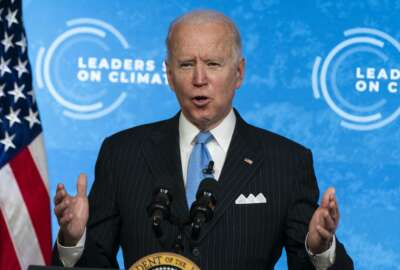

Federal agencies have some catching up to do to meet the Biden administration’s zero-emission vehicle goals. Electric vehicles make up less than 1% of the fe...
Federal agencies have some catching up to do to meet the Biden administration’s zero-emission vehicle goals.
Agencies may need to purchase as many as 30,000 zero-emission vehicles annually to meet the Biden administration’s green government goals, according to a Government Accountability Office report released last week.
President Joe Biden signed an executive order last December directing agencies to buy only zero-emission light-duty vehicles starting in 2027, and buy only zero-emission vehicles across all categories by 2035.
GAO estimates that Biden’s executive order affects about 380,000 vehicles in the federal fleet. The federal fleet in fiscal 2020 included more than 610,000 non-tactical vehicles in the U.S.
About 69% of the federal fleet are light-duty vehicles, including SUVs, pickup trucks and sedans. Less than 1% of the federal fleet is zero-emission vehicles — less than 1,600 in total.
GAO finds the federal fleet, which includes everything from sedans to ambulances and buses, traveled 4 billion miles and consumed more than 360 million gallons of fuel in fiscal 2020.
The General Services Administration told GAO that every year, agencies replace an average of about 8% of their fleet.
Agencies in fiscal 2021 ordered about 45,000 vehicles, the equivalent of replacing 12% of their fleets. Of those, agencies purchased 138 battery electric vehicles and 119 plug-in hybrid vehicles.
About half of the 33,000 light-duty vehicles agencies purchased in 2021 had an electric vehicle alternative offered by GSA.
GAO found that GSA so far lacked electric vehicle options for larger models of SUVs and pickup trucks. GSA officials, however, told GAO they’re optimistic there will be electric vehicle options for all light-duty vehicle types within the next five years.
GSA in April established 16 Blanket Purchase Agreements for vehicle supply equipment.
GSA Administrator Robin Carnahan told GAO that these BPAs “ensure that agencies have access to the infrastructure required to charge their plug-in hybrid and battery-operated vehicles.”
“GSA hopes these efforts will make acquiring and installing EV charging infrastructure easier for federal agencies and is easier to help them meet their EV mission needs,” Carnahan wrote.
To support widespread electric vehicle use, GSA estimates the federal government may need over 100,000 charging ports across the U.S.
GAO found access to electric vehicle charging infrastructure is generally limited at federal facilities, and widespread fleet electrification will require a “significant investment” in charging infrastructure.
Federal agencies, as of March 2022, owned and operated over 4,000 charging ports in less than 500 cities, according to data collected by the Energy Department.
More than 25% of all federally owned charging infrastructure is based in California, while the District of Columbia, which has more federal vehicles than any other ZIP code, only has 110 charging ports at 35 locations.
While federal agencies own vehicles in more than 10,000 ZIP codes, the top 300 ZIP codes contain almost half of the vehicles in federal fleets, and about 70% of the federal fleet is located in urban areas.
Meanwhile, the Energy Department and the Department of the Navy account for almost half of all federally owned charging infrastructure.
GAO found that in 2021, federal vehicles traveled an average of 6,000 miles a year, although usage varied by region.
Federal vehicles located in rural areas, for example, were generally driven 25% further, or about 1,500 miles more per year.
While federal agencies own vehicles in more than 10,000 ZIP codes, the top 300 ZIP codes contain almost half of the vehicles in federal fleets, and about 70% of the federal fleet is located in urban areas.
GSA generally agreed with GAO’s findings, but added that federal vehicle use was affected by the COVID-19 pandemic.
“The exact effect is uncertain since reported annual mileage was decreasing before the pandemic every year from 2017 to 2019,” GAO wrote.
Congress and multiple administrations have sought to reduce the federal government’s reliance on gas-powered vehicles and cut its greenhouse gas emissions over the past 30 years.
Senate Homeland Security and Governmental Affairs Committee Chairman Gary Peters (D-Mich.), House Oversight and Reform Committee Chairwoman Carolyn Maloney (D-N.Y.) and Government Operation Subcommittee Chairman Gerry Connolly (D-Va.) requested GAO conduct the report.
GAO said the electric vehicle market is expected to show continued growth, considering federal, state and local government incentives to purchase electric vehicles.
“However, electrifying federal fleets represents a significant transformation in the federal government’s approach to vehicle procurement and will require a shift in perceptions about their capability to adequately meet mission needs in terms of performance and driving range,” GAO wrote.
Electric vehicles generally have a higher price tag than their gas-powered counterparts. GAO said this would require agencies to make a larger spending commitment upfront, but may recover some costs through lower maintenance and fuel costs for EVs.
GSA officials told GAO that the barrier to greater purchase of electric vehicles “would continue to decline as production increases and manufacturing costs decline.”
Congress and the Biden administration have pressured the Postal Service to embrace the White House’s climate goals and invest in electric vehicles.
However, GAO wrote in its report that USPS “is not subject to the executive order,” because it is not an executive agency.
Meanwhile, USPS received $3 billion in the Inflation Reduction Act to expand on its plans to electrify its fleet.
Maloney is asking USPS how many more electric vehicles it’ll be able to buy with the $3 billion it received, and how it will build out the necessary charging infrastructure.
Maloney is also asking whether USPS plans to make its chargers available for public use.
Copyright © 2024 Federal News Network. All rights reserved. This website is not intended for users located within the European Economic Area.
Jory Heckman is a reporter at Federal News Network covering U.S. Postal Service, IRS, big data and technology issues.
Follow @jheckmanWFED



